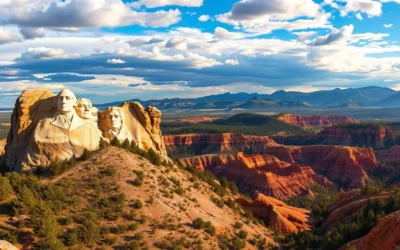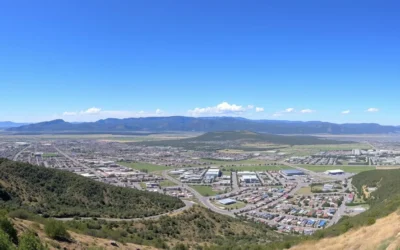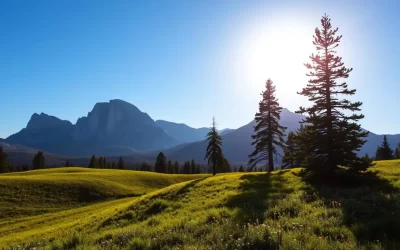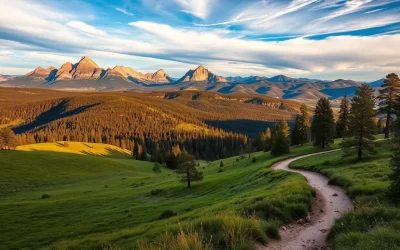✓ Accommodations✓ Flights✓ Rental Cars
Imagine standing amidst a surreal landscape of colorful buttes, spires, and pinnacles that defy the ordinary. Badlands National Park in South Dakota offers just that, with its unique terrain and diverse wildlife.
Spanning over 244,000 acres, this natural wonder is home to bison, prairie dogs, and mountain goats, among other wildlife. The park’s name, derived from the Lakota people’s “mako sica,” meaning “bad lands,” reflects the challenging conditions of this rugged terrain.
As you plan your trip to this remarkable destination, you’ll discover a range of experiences. From scenic drives and hiking trails to wildlife viewing opportunities, there’s something for everyone at this national park. Whether you have a few hours or several days, this guide will help you make the most of your time exploring the park’s things to see and do.
Discovering the Unique Landscape of Badlands National Park
Badlands National Park is a place where the forces of nature have created a world of striking beauty and geological wonder. The park’s landscape is characterized by its unique terrain, which has been shaped by millions of years of deposition and erosion.
The Geological Wonder of the Badlands
The Badlands are a type of dry terrain where softer sedimentary rocks and clay-rich soils have been extensively eroded by wind and water. This process has resulted in the formation of steep slopes, minimal vegetation, and a lack of substantial regolith, alongside high drainage density.
The geological formations in the Badlands are a key feature, with canyons, ravines, gullies, buttes, mesas, hoodoos, and other geologic forms being common. The formations continue to erode at a rate of about one inch per year, making the Badlands one of the fastest-changing landscapes in the world.
Why It’s Called “The Badlands”
The name “Badlands” originates from the Lakota term “mako sica” and the French-Canadian “les mauvais terres pour traverse.” Both terms refer to the difficult terrain, extreme temperatures, and lack of water that made this area challenging for travelers.
The vibrant colors seen throughout the park—purples, reds, oranges, yellows, and whites—come from different minerals in the rock layers. Iron produces the reds and yellows, while volcanic ash creates the whitish layers. The Yellow Mounds area is particularly notable for its ancient fossil soils, or paleosols, which have been transformed by exposure to oxygen, creating a striking yellow landscape.
| Geological Feature | Description | Formation Process |
|---|---|---|
| Yellow Mounds | Ancient fossil soils turned yellow | Exposure to oxygen |
| Canyons and Ravines | Deep, narrow valleys | Erosion by water and wind |
| Hoodoos | Tall, thin rock formations | Erosion of softer rocks |
Planning Your Visit to Badlands National Park
To make the most of your visit to Badlands National Park, it’s essential to plan ahead. Understanding the best times to visit, knowing the entrance fees, and being aware of how to get to the park can significantly enhance your experience.
Best Time to Visit
The Badlands National Park is open 7 days a week, 24 hours a day, but the time you choose to visit can greatly impact your experience. According to a ranger, the period from mid-April to mid-May is ideal due to fewer crowds and the vibrant greenery. Alternatively, fall is also a great season to visit as the changing light creates dramatic effects on the rock formations.
Visiting during summer can be challenging due to the intense heat, with temperatures often exceeding 100°F. If you do visit in the summer, plan your hikes and explorations for early morning or evening to avoid the heat.
Winter visits offer a serene experience with snow-dusted formations and minimal crowds, with only 50-100 visitors per day. However, some services may be limited, and roads can become impassable after snowstorms.
| Season | Characteristics | Visitor Experience |
|---|---|---|
| Spring (mid-April to mid-May) | Mild weather, wildflowers in bloom | Fewer crowds, greenery |
| Summer | High temperatures (over 100°F) | Large crowds, early morning/evening hikes recommended |
| Fall | Dramatic light effects on rock formations | Manageable crowds, pleasant weather |
| Winter | Snow-dusted formations, limited services | Minimal crowds (50-100 visitors/day), potential road closures |
Entrance Fees and Passes
The entrance fee for Badlands National Park is $30 per vehicle, valid for 7 days. If you plan to visit multiple national parks within a year, consider purchasing an America the Beautiful Annual Pass for $80.
How to Get There
Badlands National Park has three main entrances: the Northeast Entrance (from I-90 Exit 131), the Pinnacles Entrance (from I-90 Exit 110 near Wall), and the Interior Entrance (via Highway 44). The Northeast Entrance is the most convenient for visitors coming from Rapid City.
![]()
Driving the Scenic Badlands Loop Road
The Badlands Loop Road, or Highway 240, is a 30-mile scenic drive that takes you through some of the most spectacular landscapes in Badlands National Park. This paved road is designed to showcase the park’s unique geological formations and diverse wildlife, making it an unforgettable experience for visitors.
Route Overview and Highlights
As you drive along the Loop Road, you’ll be treated to constantly changing perspectives of the dramatic Badlands landscape. The road connects to I-90 on both ends, making it an easy detour for those traveling through the area. While the drive itself takes about an hour without stops, it’s recommended to allocate at least 3-4 hours to fully enjoy the numerous overlooks, short hikes, and the visitor center along the route.
The Badlands Loop Road is dotted with 16 overlooks, each offering a unique view of the park’s breathtaking scenery. The road twists and turns along “the Wall,” a 60-mile stretch of eroded, jagged rocks that separate the upper and lower prairies.
Must-Stop Overlooks Along the Way
Some of the must-visit overlooks include:
- Big Badlands Overlook, which is spectacular at sunrise, offering a panoramic view of the Badlands.
- Pinnacles Overlook, perfect for sunset, with its unique rock formations.
- Yellow Mounds Overlook, known for its colorful hills that change hues with the light.
- Panorama Point, which provides expansive views of the surrounding landscape.
- Burns Basin Overlook, not only for its views but also for the prairie dog town located across the street, offering great wildlife viewing opportunities.
By stopping at these overlooks and taking short hikes, you’ll experience the full beauty and diversity of Badlands National Park. Whether you’re driving through or stopping to explore, the Badlands Loop Road is an adventure not to be missed.
Top Hiking Trails in Badlands National Park
With trails catering to all abilities, Badlands National Park is a hiker’s paradise. The park offers a variety of trails that allow you to explore its unique landscapes up close.
Notch Trail: The Park’s Most Adventurous Hike
The Notch Trail is a 1.5-mile round-trip hike that is perfect for those looking for adventure. It features a scenic canyon, a climb up a wooden ladder, and a narrow ledge walk that ends with a stunning view of the White River Valley. This trail is great for adventurous kids and adults alike.
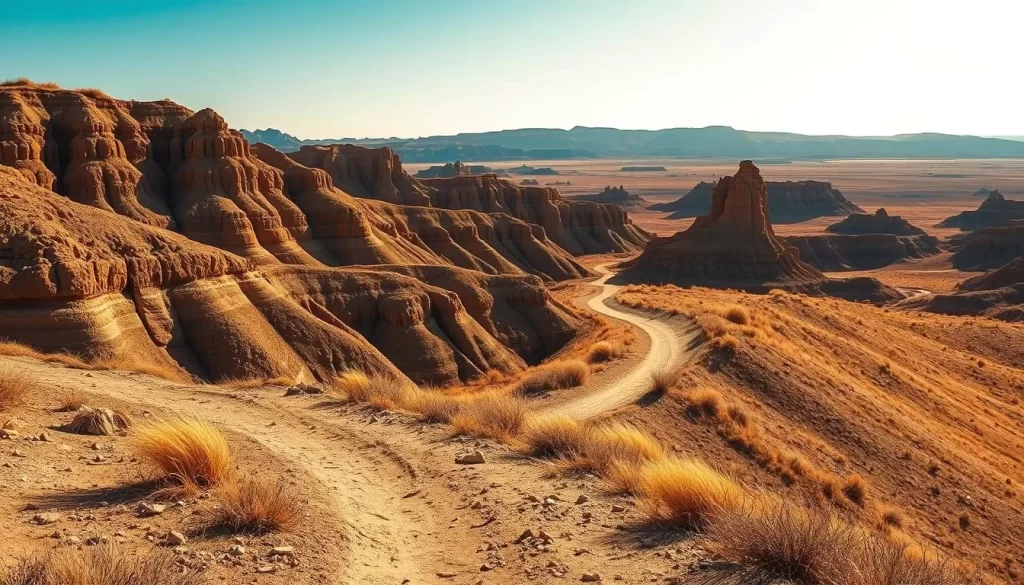
Door Trail: Step into the Badlands
The Door Trail is a 0.75-mile round-trip hike that is flat and accessible to almost all ability levels. It begins with a boardwalk section before venturing into the Badlands formations, offering a unique and up-close experience of the park’s terrain.
Castle Trail: The Park’s Longest Trail
For those looking for a longer hike, the Castle Trail is a 10-mile round-trip journey that cuts through the heart of the Badlands. It connects two points on Badlands Loop Drive and takes you through diverse landscapes, including mixed-grass prairie and badlands formations, with opportunities to spot wildlife.
Other Notable Trails
In addition to the Notch, Door, and Castle Trails, Badlands National Park offers several other notable hiking trails. These include:
- The Window Trail, a 0.25-mile fully accessible boardwalk trail perfect for families.
- The Fossil Exhibit Trail, another 0.25-mile accessible trail that showcases the park’s fossil heritage.
- The Saddle Pass Trail, a 0.5-mile round-trip hike that offers a moderate challenge and panoramic views of the surrounding badlands.
These trails offer a range of experiences, from easy and accessible walks to more challenging hikes, ensuring that there’s something for every visitor to Badlands National Park.
Best Overlooks for Spectacular Views
One of the main attractions of Badlands National Park is its array of overlooks that provide stunning views. These overlooks offer visitors a chance to experience the park’s unique geological formations and breathtaking vistas.
Pinnacles Overlook
Pinnacles Overlook is one of the most visited overlooks in the park and is absolutely worth the visit. It changes dramatically depending on the lighting, offering one of the park’s most expansive views. The formations here transform throughout the day, making it a great spot to visit at different times.
Big Badlands Overlook
Big Badlands Overlook offers a view of an enormous section of zebra-striped hills. The view is jaw-dropping, and this is a magical place at sunrise when the first light illuminates the striped formations with a golden glow.
Yellow Mounds Overlook
Yellow Mounds Overlook gives you a view of the yellow hills of the Badlands. The park’s most colorful formations are showcased here, where ancient fossil soils create vibrant yellow hills that contrast beautifully with the surrounding landscape.
Panorama Point
Panorama Point requires a walk on a short boardwalk trail to a stunning viewpoint. It’s beautiful during the day and gorgeous at sunset. This spot tends to be less crowded than other popular overlooks, making it an ideal sunset spot.
The park’s overlooks are a key part of the Badlands experience. Here are some highlights:
- Pinnacles Overlook offers expansive views that change dramatically throughout the day.
- Big Badlands Overlook is widely considered the most spectacular viewpoint, especially at sunrise.
- Yellow Mounds Overlook showcases the park’s most colorful formations.
- Panorama Point features a short boardwalk trail to a sweeping vista.
The Badlands National Park’s overlooks are not just visually stunning; they also provide a deeper understanding of the park’s geological history. Each overlook has its unique charm and offers a different perspective on the Badlands.
Wildlife Viewing Opportunities
Badlands National Park is a haven for wildlife enthusiasts, offering a chance to see a wide range of animals in their natural environment. As you drive through the park, you may stumble across many different wildlife species, including bison, prairie dogs, sheep, goats, ferrets, and birds.
Bison and Bighorn Sheep
The park is home to a diverse range of wildlife, including bison and bighorn sheep. These iconic species are a highlight for many visitors. Bison, also known as American buffalo, roam freely in the park, while bighorn sheep can be seen scaling the rocky cliffs.
Roberts Prairie Dog Town
One of the park’s most fascinating attractions is the Roberts Prairie Dog Town, located on Sage Creek Rim Road. This is a great place to observe prairie dogs, who form complex “towns” with their burrows and family units. The prairie dogs will often sit at the openings of their burrows, barking warning cries to their companions as potential threats approach.
Wildlife Safety Tips
While viewing wildlife is an exciting experience, it’s essential to maintain a safe distance. Keep at least 100 feet between you and bison, and 25 feet between you and other wildlife. Use binoculars for a closer look, and never feed or approach wild animals. Be aware of rattlesnakes, especially during warm months, and stay on established trails.
The park’s diverse wildlife is supported by its unique mixed-grass prairie ecosystem. Here are some key points to enhance your wildlife viewing experience:
- Badlands National Park is home to North America’s largest mixed-grass prairie ecosystem, supporting a wide variety of wildlife.
- The best time for wildlife viewing is during early morning or late evening, particularly along Sage Creek Rim Road.
- Roberts Prairie Dog Town offers a unique insight into the social structure of prairie dogs.
- Maintain a safe distance from wildlife and use binoculars for closer views.
- Be cautious of rattlesnakes and stay on designated trails.
| Wildlife | Viewing Tips |
|---|---|
| Bison | Maintain at least 100 feet distance |
| Prairie Dogs | Visit Roberts Prairie Dog Town |
| Bighorn Sheep | Look for them on rocky cliffs |

Badlands National Park, South Dakota: Best Things to Do for Photography Enthusiasts
Badlands National Park is a must-visit destination for anyone passionate about photography. The park’s unique landscape, with its striking rock formations and vast prairies, offers endless opportunities to capture breathtaking images.
Sunrise and Sunset Photography Spots
The golden hours, which occur during the first and last two hours of daylight, are ideal for capturing the park’s natural beauty. Sunrise is particularly special as the early morning light illuminates the rock formations with warm tones, and you’re likely to have popular spots mostly to yourself.
For sunrise photography, Big Badlands Overlook is highly recommended. The first light of day brings out the vibrant colors of the striped formations, creating a spectacular scene. For sunset, both Pinnacles Overlook and Panorama Point offer stunning views, though Pinnacles Overlook can get crowded.
| Photography Spot | Best Time | Notable Feature |
|---|---|---|
| Big Badlands Overlook | Sunrise | Vibrant colors of striped formations |
| Pinnacles Overlook | Sunset | Spectacular views of rock formations |
| Panorama Point | Sunset | Panoramic views with fewer crowds |
Night Sky and Stargazing Photography
Badlands National Park is designated as an International Dark Sky Park, making it an exceptional location for night photography and stargazing. The minimal light pollution allows for clear views of the night sky, providing opportunities to capture the Milky Way and other celestial wonders.
To make the most of your photography experience, avoid shooting during the harsh midday sun (between 10 am and 2 pm), when the light can create unflattering shadows and contrast. Instead, plan your shots during the golden hours when the soft, directional light enhances the textures and colors of the formations.
Exploring the Visitor Centers
Badlands National Park offers two main visitor centers that serve as excellent starting points for your adventure. These centers are not only information hubs but also provide insights into the park’s geology, paleontology, and cultural history.
Ben Reifel Visitor Center
The Ben Reifel Visitor Center is open year-round and is a must-visit for anyone looking to understand the park’s unique features. It boasts a great souvenir shop, free exhibits, a bookstore, and clean bathrooms. Park staff are available to answer any questions you may have, making it an ideal first stop.
Key Features:
- Interactive exhibits that provide insights into the park’s geology and paleontology.
- A fossil preparation lab where you can watch paleontologists at work.
- A bookstore with a wide range of materials about the park.
The center is located next to the Cedar Pass Lodge, which is open during spring, summer, and fall, offering a restaurant, an amphitheater, and campgrounds.
White River Visitor Center
The White River Visitor Center, located in the Pine Ridge Indian Reservation, is open seasonally during spring, summer, and fall. It offers a unique perspective on the park by providing insights into the Oglala Lakota culture and history.
Key Features:
- Information about the Oglala Lakota culture and history.
- Serves as a trailhead for several popular hikes.
- Provides information about current trail conditions and wildlife sightings.
Both visitor centers are essential resources for planning your visit to Badlands National Park. They offer valuable information that can enhance your understanding and appreciation of the park.
| Visitor Center | Operating Season | Key Features |
|---|---|---|
| Ben Reifel Visitor Center | Year-round | Fossil preparation lab, interactive exhibits, bookstore |
| White River Visitor Center | Spring, Summer, Fall | Oglala Lakota culture and history, trailhead for hikes |
Camping and Accommodation Options

For those visiting Badlands National Park, the choice of where to stay can greatly impact the overall experience, with several camping and accommodation options available. Whether you’re looking for a primitive camping experience or the comfort of a lodge, Badlands National Park has something to offer.
Cedar Pass Campground
Cedar Pass Campground is a convenient and scenic option, offering 96 level sites with stunning views of the Badlands formations. This campground is equipped with electric hookups for RVs, making it suitable for a wide range of camping needs.
It’s located near the Ben Reifel Visitor Center, providing easy access to park information and the Cedar Pass Lodge restaurant. It’s worth noting that Cedar Pass Campground takes reservations and is open year-round, except for some seasonal closures. Campfires are not permitted, and collecting firewood is also not allowed.
Sage Creek Campground
For a more primitive experience, Sage Creek Campground offers 22 free sites on a first-come, first-served basis. This campground is particularly appealing to those who enjoy wildlife viewing, as bison often wander through the area.
Sage Creek has pit toilets but no water, and the trailer size is limited to 18 feet, although this restriction does not apply to horse trailers, making it one of the designated horse camping areas.
Cedar Pass Lodge
If camping isn’t your preference, Cedar Pass Lodge provides a comfortable alternative with 27 eco-friendly cabin units. Each cabin is equipped with private bathrooms and air conditioning, offering a relaxing stay amidst the beautiful Badlands landscape.
The lodge’s cabins start at around $228 per night, providing a luxurious and serene getaway. Additionally, for those who prefer hotel accommodations, the nearby towns of Wall and Interior offer several motels and hotels at various price points.
For the more adventurous, backcountry camping is also an option in Badlands National Park, allowing for a truly immersive wilderness experience. Visitors can camp anywhere that is at least half a mile from a road or trail and not visible from roads or developed areas.
Exploring the Backcountry
Badlands National Park is one of the few national parks that allows visitors to venture into the backcountry without the constraint of designated trails. This unique opportunity enables you to explore the park’s rugged and untouched natural beauty on your own terms.
Before you head out, it’s essential to be prepared. Make sure to sign the Backcountry Register with your vehicle and trip details. This crucial step ensures that park rangers are aware of your plans and can respond accordingly in case of an emergency.
Sage Creek Wilderness Area
The Sage Creek Wilderness Area, located in the western section of the park, offers a pristine mixed-grass prairie teeming with wildlife. You can access this area from several points, including the Sage Creek Campground and the Sage Creek Basin Overlook. As you hike through this untouched landscape, keep an eye out for bison herds and pronghorn, making it an excellent spot for wildlife enthusiasts.
Deer Haven Wilderness Area
For a more rugged backcountry experience, the Deer Haven Wilderness Area is a must-visit. Accessible via an unmaintained trail starting from the Conata Picnic Area, this area boasts dramatic formations and isolated canyons. The challenging terrain makes it an ideal destination for experienced hikers seeking solitude and adventure.
When exploring the backcountry, it’s crucial to be well-prepared. Here are some key tips to keep in mind:
- Carry plenty of water (at least one gallon per person per day) to stay hydrated.
- Bring navigation tools, as the terrain can be disorienting.
- Practice Leave No Trace principles to preserve the park’s natural beauty.
- Be prepared for sudden weather changes, which can occur rapidly in the Badlands.
- Consider taking photos of your route or using GPS tracking to ensure you can find your way back to your starting point.
| Area | Access Points | Notable Features |
|---|---|---|
| Sage Creek Wilderness Area | Sage Creek Campground, Sage Creek Basin Overlook | Mixed-grass prairie, bison herds, pronghorn |
| Deer Haven Wilderness Area | Conata Picnic Area | Dramatic formations, isolated canyons |
By following these guidelines and being mindful of your surroundings, you can have a safe and enjoyable experience exploring the backcountry of Badlands National Park. Whether you choose to venture into the Sage Creek Wilderness Area or the Deer Haven Wilderness Area, you’re sure to be rewarded with unforgettable landscapes and a deeper connection with nature.
Nearby Attractions Worth Visiting
The vicinity of Badlands National Park offers a variety of attractions that cater to different interests. If you’re planning to visit the park, you might want to consider exploring some of the other places in the area to make the most of your trip.
Wall Drug
Just 8 miles from the park’s Pinnacles Entrance, Wall Drug has evolved from a small pharmacy into a sprawling tourist attraction. This cowboy-themed mall now features several restaurants, shops, an art gallery, and even a small chapel. According to the New York Times, Wall Drug is “a sprawling tourist attraction of international renown that draws some two million annual visitors to a remote town.” You can enjoy homemade donuts and buffalo burgers, take photos with giant jackalopes and dinosaurs, or explore the “backyard” area with numerous Instagram-worthy spots.
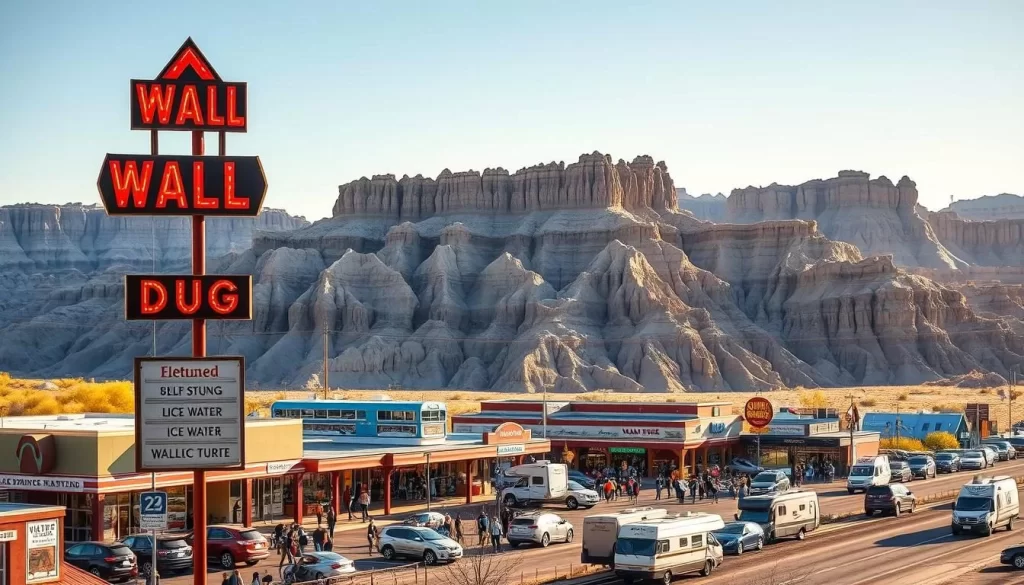
Minuteman Missile National Historic Site
For a dose of history, visit the Minuteman Missile National Historic Site, which preserves relics from the Cold War era. This site allows visitors to tour an actual nuclear missile silo and control center that once housed weapons capable of reaching the Soviet Union in 30 minutes. The Launch Control Facility for Delta-01 and the Delta-09 Missile Silo are the two facilities that are part of the nuclear missile field.
The Town of Wall
The town of Wall itself is another place worth visiting, with several accommodation options and restaurants. You might also want to check out Dahl’s Chainsaw Art, a newer attraction featuring impressive wood carvings, including a giant jackalope that you can climb inside. For those interested in pioneer history, the nearby Prairie Homestead Historic Site features an authentic 1909 sod home, offering insights into what life was like for early settlers on the South Dakota prairie.
These attractions offer a great way to enhance your visit to Badlands National Park, providing a mix of culture, history, and entertainment. Whether you’re interested in the quirky side of roadside America or in delving into the region’s history, there’s something for everyone near Badlands National Park.
How Much Time to Spend in Badlands National Park
The amount of time you should spend in Badlands National Park largely depends on your interests and what you want to achieve during your visit. Most people will spend about 4 hours in the park, but this can vary greatly depending on your level of adventure and the activities you have planned.
If you’re an extreme adventurer or want to explore all the trails offered, drive the entire Loop Road, or see the South Unit, you may want to schedule an entire day. With half a day, you can drive Badlands Loop Road, visit several of the overlooks, and hike a short trail like the Notch Trail, the Door Trail, or hiking up Saddle Pass to the Castle Trail.
One-Day Itinerary
With one day in Badlands National Park, you can experience the park’s highlights. Start with sunrise at Big Badlands Overlook, then hike the Notch and Door Trails in the morning. Drive the Badlands Loop Road with stops at key overlooks, visit the Ben Reifel Visitor Center, and end with sunset at Pinnacles Overlook.
- Start your day with sunrise at Big Badlands Overlook
- Hike the Notch and Door Trails in the morning
- Drive the Badlands Loop Road with stops at key overlooks
- Visit the Ben Reifel Visitor Center
- End your day with sunset at Pinnacles Overlook
Two-Day Itinerary
With two days in Badlands National Park, you can add more in-depth experiences to your trip. Spend your second day exploring the western section along Sage Creek Rim Road for wildlife viewing, venture into the backcountry wilderness areas, and visit nearby attractions like Minuteman Missile National Historic Site.
| Day | Morning | Afternoon | Evening |
|---|---|---|---|
| 1 | Sunrise at Big Badlands Overlook, hike Notch and Door Trails | Drive Badlands Loop Road, visit Ben Reifel Visitor Center | Sunset at Pinnacles Overlook |
| 2 | Explore Sage Creek Rim Road for wildlife viewing | Venture into backcountry wilderness areas | Visit Minuteman Missile National Historic Site |
If you’re short on time, prioritize the eastern section of the park where the most dramatic formations are located, and make sure to experience at least one short hike that gets you up close to the unique landscape.
Many visitors combine Badlands National Park with a larger Black Hills trip that includes Mount Rushmore, Custer State Park, and Wind Cave National Park, typically allowing 1-2 days for the Badlands portion of their journey.
Conclusion: Why Badlands National Park Is Worth Visiting
Badlands National Park, South Dakota, is a place where the forces of nature have created a world of rugged beauty and awe-inspiring landscapes. The park’s unique landscape, shaped by millions of years of erosion, continues to captivate visitors from around the world.
The Badlands offer a range of experiences for different types of visitors. For those who want to take in the views from the comfort of their car, the Badlands Loop Road provides dramatic vistas at every turn. For the more adventurous, there are numerous hiking trails that cater to all ability levels, from the easy Door Trail to the more challenging Notch Trail.
One of the park’s most compelling features is its wildlife. The mixed-grass prairie ecosystem is home to a variety of species, including bison, bighorn sheep, and prairie dogs. Visitors can enjoy wildlife viewing opportunities, with the chance to see these animals in their natural habitat.
The remote location of the Badlands means that the night sky is incredibly dark, making it an ideal spot for stargazing and astrophotography. Many photographers camp out to capture the stunning sunset or sunrise, and the open skies provide the perfect backdrop for these breathtaking moments.
Whether you visit for a few hours or several days, Badlands National Park leaves a lasting impression with its stark beauty, dramatic sunrises and sunsets, and the profound sense of geological time visible in its layered rock formations. It is a destination that is well worth the drive from the Black Hills region, and its unique blend of natural beauty and outdoor adventure makes it a must-visit for anyone who loves the great outdoors.
The above is subject to change.
Check back often to TRAVEL.COM for the latest travel tips and deals.

